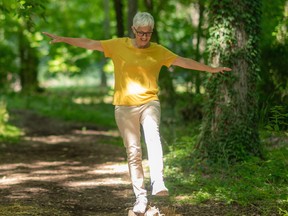Breadcrumb Trail Links
Diet & Fitness
Published Oct 27, 2024 • Last updated 13 hours ago • 2 minute read
You can save this article by registering for free here. Or sign-in if you have an account.
 Senior woman doing balance exercises in the park to maintain agility and stability. Getty ImagesArticle content
Senior woman doing balance exercises in the park to maintain agility and stability. Getty ImagesArticle content
Reviews and recommendations are unbiased and products are independently selected. Postmedia may earn an affiliate commission from purchases made through links on this page.
Advertisement 2
This advertisement has not loaded yet, but your article continues below.
THIS CONTENT IS RESERVED FOR SUBSCRIBERS ONLY
Subscribe now to read the latest news in your city and across Canada.
Unlimited online access to articles from across Canada with one account.Get exclusive access to the Toronto Sun ePaper, an electronic replica of the print edition that you can share, download and comment on.Enjoy insights and behind-the-scenes analysis from our award-winning journalists.Support local journalists and the next generation of journalists.Daily puzzles including the New York Times Crossword.
SUBSCRIBE TO UNLOCK MORE ARTICLES
Subscribe now to read the latest news in your city and across Canada.
Unlimited online access to articles from across Canada with one account.Get exclusive access to the Toronto Sun ePaper, an electronic replica of the print edition that you can share, download and comment on.Enjoy insights and behind-the-scenes analysis from our award-winning journalists.Support local journalists and the next generation of journalists.Daily puzzles including the New York Times Crossword.
REGISTER / SIGN IN TO UNLOCK MORE ARTICLES
Create an account or sign in to continue with your reading experience.
Access articles from across Canada with one account.Share your thoughts and join the conversation in the comments.Enjoy additional articles per month.Get email updates from your favourite authors.
THIS ARTICLE IS FREE TO READ REGISTER TO UNLOCK.
Create an account or sign in to continue with your reading experience.
Access articles from across Canada with one accountShare your thoughts and join the conversation in the commentsEnjoy additional articles per monthGet email updates from your favourite authors
Don’t have an account? Create Account
or
Sign in without password New , a new way to login
Article content
In a tale as old as time, people have been trying to live longer and look and feel younger.
There are many ways an individual’s biological age can be determined, whether it’s through internal biomarkers or physical evidence of aging.
But according to a new study published in the journal, PLOS One, there’s a less invasive way to find out if your body is ahead or behind your chronological age.
It turns out, balance is key.
Researchers from the Mayo Clinic say the amount of time a person can balance on one leg is a critical indicator of muscle, bone, and nerve strength.
Forty healthy participants over 50 were subjected to walking and balance tests, as well as exercises that assessed their grip and knee strength.
“Balance is an important measure because, in addition to muscle strength, it requires input from vision, the vestibular system, and the somatosensory systems,” Dr. Kenton Kaufman, senior author of the study and director of the Motion Analysis Laboratory at Mayo Clinic, said in a news release.
Your Midday Sun
Thanks for signing up!
Article content
Advertisement 3
This advertisement has not loaded yet, but your article continues below.
Article content
The 30-second balance tests involved subjects standing on force plates that measured how much energy they exerted to the ground.
They were also asked to change from different positions, including two feet on the ground with eyes open, standing on one leg using their non-dominant leg with eyes open, and on their dominant leg with eyes open.
The results showed that participants standing on their non-dominant leg showed the highest rate of decline with age.
RECOMMENDED VIDEO
We apologize, but this video has failed to load.
Play Video
Kaufman noted: “If you look at all these factors that decrease with age, the ability to balance on one leg was affected the most, or declined the most, with age.”
It was also noted that muscle mass decreases up to 8% per decade after the age of 30, a rate that increases from 60 years and onward.
Advertisement 4
This advertisement has not loaded yet, but your article continues below.
Article content
“If you can balance on your leg for 30 seconds, and you’re over 65, you’re doing very well,” Kaufman told AARP.
“The number that causes concern is if you can’t balance for 5 seconds.”
The study authors hope the test will encourage people to test their bone strength on their own.
“This finding is significant because this measurement does not require specialized expertise, advanced tools, or techniques for measurement and interpretation. It can be easily performed, even by individuals themselves,” they said.
Recommended from Editorial

‘DRAMATIC CHANGES:’ Study shows aging speeds up in mid-40s, early 60s

Canadians are walking themselves to better health with this simple exercise

Add 24 years to your life with these eight habits
However, Kaufman warned that changes in balance could mean serious implications.
“If you have poor balance, you’re at risk of falling, whether or not you’re moving,” he said. “Falls are a severe health risk with serious consequences.”
Staying physically active and keeping up with strength training as you age can help you maintain and improve balance.
“A little practice won’t hurt either,” said Kaufman, who says he stands on one leg at least once a week.
“It’s easy to do. It doesn’t require special equipment, and you can do it every day.”
Article content
Share this article in your social network
